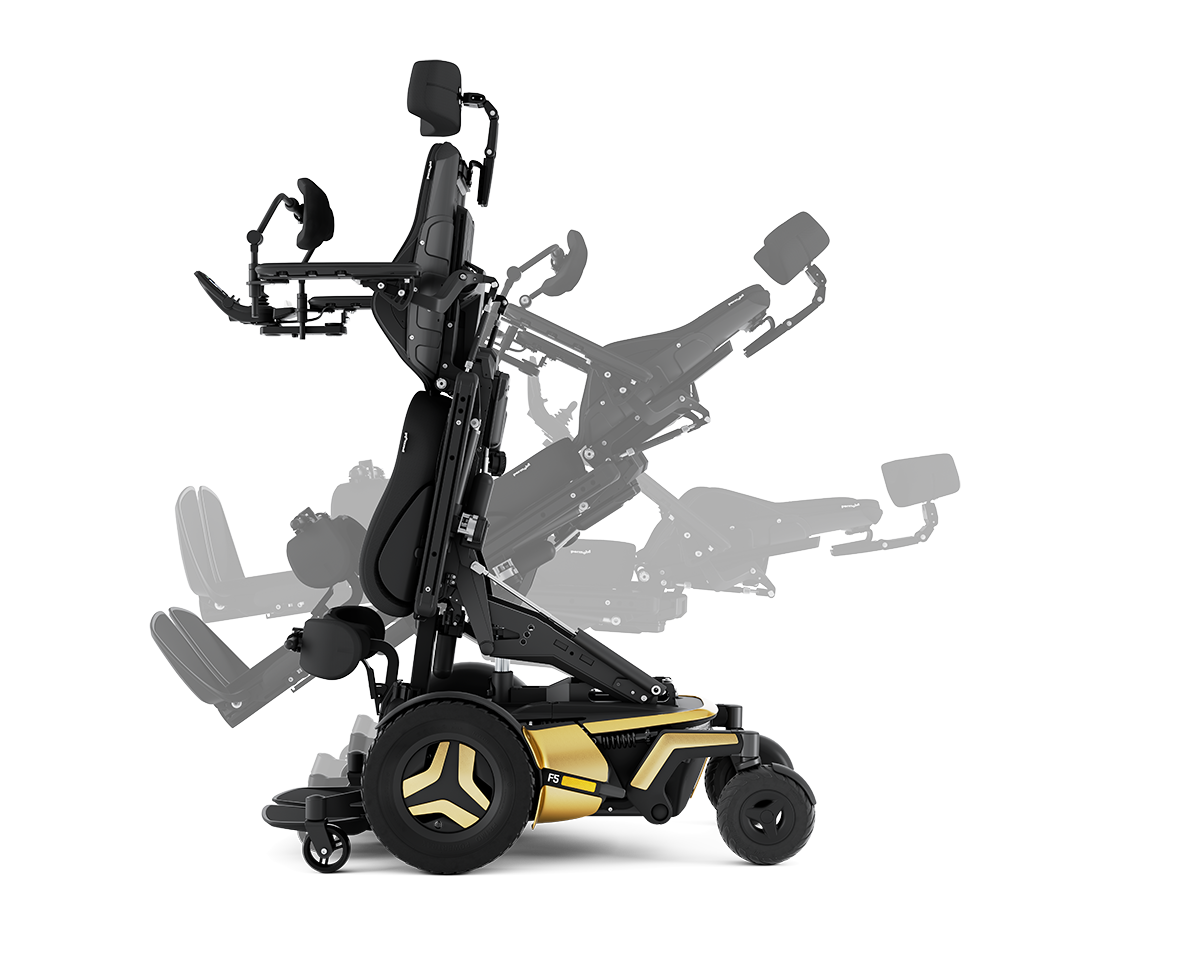In this third and final blog on navigating the fine line that is scripting a power wheelchair, I want to leave you with a couple of thoughts.
Firstly, if one of the most important goals for your client is maintaining their ride position as they are using alternative controls, switches or perhaps are using an Augmentative and Alternative Communication (ACC) device to communicate; considering a Power Wheelchair (PWC) with high-spec suspension and power would be important. Additional suspension, independent caster arm articulation and drive wheel movement, 500W motors and increased torque; are an ideal prescription for clients who need to maintain their ride position.
The higher level of suspension, vibration dampening, and increased climbing ability helps the client maintain their seated position as there is less movement at the seat. They are then less likely to be moved (even a couple of cm’s) and will therefore continue to be independent in their mobility and/or communication. For these clients, millimeters matter and I would be doing everything in my capacity to minimise any movement that they may experience at the seat.
As with all other aspects of a PWC, power seat functions also differ between chairs and manufacturers. Each marketing department does a great job of calling the same function something else – which makes comparing apples with apples tricky at times! As each Power Seat Function (PSF), parameters can differ between chairs, I often see clients who would benefit from additional PSFs, or equally who have been over prescribed PSFs.

When trialling and comparing PSFs between chairs, a few factors to consider would be:
- Compare and trial each PSF when comparing PWCs. Use the same functional task or assessment. Don’t assume they will be the same. There is a 2” difference between the Permobil 3 Series and 5 Series chair for ActiveHeightTM. This 12” of height could be plenty to maximise your client’s function in their workplace or home, however for some an additional 2 inches of reach – taking it to 14” may mean that home modifications are not required, or care could be reduced. Do the same for anterior and posterior tilt – as these end point ranges can differ between chairs. Demonstrate how the extra amount of tilt or reach will have a functional impact, potentially reduce care or increases participation. Pair your functional assessments with a standardised outcome measure.
- Where the seat is placed on the base may differ slightly between chairs too, especially for Front Wheel Drive (FWD) and Mid Wheel Drive (MWD) chairs. The seat is typically placed to maximise the stability of the chair. This position of the seat on one base may differ between a FWD and MWD chair. If a functional PSF such as anterior reach is not quite as functional as it could be, consider trialing the same task and PSF on a different base. Prescribing a FWD chair over a MWD chair may enable your client to reach higher or get closer to their environment. One of the great elements of the Permobil AP actuator is that when the chair goes into ActiveReachTM, the seat also moves back to maximise the stability of the chair.
- Suspension lockout refers to the suspension not being operational during mobilisation and PSF use. – Different chairs are designed to go into lock out mode at different points to maximise safety and decrease the risk of the chair tipping. Lock out means that there is no active suspension or independent movement of the wheels. This is an important factor to consider if prescribing PSFs which will be used when a client is actively mobilising.
- What programming is available for each seat function? Are you able to stop or lock a function at a certain point due to reduced cognition or safety concerns?
- Can the sequences of the programming be changed? E.g. can the chair go from a supine position to standing AND from tilt or sitting to standing too? The ability to program sequences, and change the angles and sequences at time of delivery or in the future is important, especially for clients with variable or declining conditions. Conversely – simple is great for many clients. Don’t over complicate PSFs if you don’t need to. For many, using PSF in a simple manner works well and allows for clients to meet their function and mobility goals.
Finally – I hope that the last three blogs have been thought provoking and encouraged you to consider the functional and clinical benefits of different elements of PWCs. Not all chairs are created equal – and thinking about them in a functional manner instead of the parts should make prescription and the clinically reasoning an easier and more functional task for both you and the client!
Stay true to yourself as an OT, think function, function, function! This will help you to remove your ‘go to’ pieces of equipment and open up the avenue for a larger scope of AT practice. And if in doubt, pick up the phone and find a mentor, co-worker or supervisor and chat through the clinical application and the pros and cons of each chair. We can be contacted at education.au@permobil.com (AU) or education.nz@permobil.com (NZ).

Tilly Brook
Clinical Services Specialist
Permobil APAC
Tilly Brook graduated from the University of Adelaide in 2008 with a Bachelor of Health Science followed by a Masters of Occupational Therapy (Hons) in 2010 from the University of Sydney. Tilly worked within rehabilitation, working primarily with adults with a brain injury until 2015 when she moved to Singapore. In Singapore, she worked with children and adults at the Cerebral Palsy Alliance School (CPAS). In 2017 Tilly’s clinical knowledge continued as she worked with Mobility Solutions in Auckland, New Zealand.
On her return to Australia, Tilly assisted in the development of the Clinical Hub Team at Sunrise Medical where her passion and experience for mentoring and educating therapists grew. Tilly Joined Permobil in January 2022 and is driven to grow therapists, enabling them to be the best therapist they can be.
